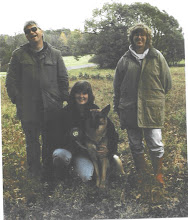Well, I didn’t figure out who our morning musician is, but I did decide that, since I was already out anyway, I might as well go lay a track for Milo. In theory I love going out to lay a track first thing in the morning. In practice, it’s hard to get dressed to leave the house, when I’m usually still padding around in pajamas and bathrobe with a steaming mug of tea. Actually, I scarcely qualified as “dressed” this morning, which I realized when I got back home and looked in the mirror to see my hair unbrushed, my shirt askew, with the collar cockeyed, and my nice blazer now covered with stick-tights. I don’t normally wear a blazer to lay a track. In fact, I don’t normally wear a blazer at all. It just happened to be the nearest thing when I grabbed for something to keep me warm in my not-quite-awake state. I was also wearing crocs, not my hiking boots, because that was what was by the door as I hurried out. Did you know that laying a track on a dewy morning in crocs is akin to taking a foot bath?
The field was heavy with dew and had a magical feel in the quiet of early morning. Apricot colored clouds piled high in the sky, shimmering in the sunrise. Fortunately, given my atypical garb, I was alone in the field—always a plus for this nature-loving introvert. I found my two points and walked, then looked back to see my path clear and straight, dark green through the light-colored wet grass. Birds called, but otherwise the morning was quiet. Too cool for insects to be on the move yet, but the wildflowers were raising their pretty faces to the sun. I lost myself in the joy of being out alone, and didn’t notice the stick-tights or the wet pant legs and socks until I got back to my car. And I didn’t care then, either; it had been the perfect start to my day.
Three and a half hours later I returned to the field with my happily dancing Beagle, both of us eager to run the track. The fields were now dry in the sunshine, the fragrance of fall-on-a-warm-day filling the air. A fragrance that instantly brings a kaleidoscope of memories to mind—riding my bike through leafy paths as a young child; running through cabbage fields for cross-country practice in high school; toting a heavy bag of apples across campus in college. I paused to relish my memories, then was brought back to the present by my gleeful Milo, who could hardly contain his excitement.
We ran the track, Milo tracking enthusiastically and well, me enjoying the connection with my dog, the connection with nature, and the connection with the part of myself that thrives on the simple pleasure of being outside with my dog. Another simple yet powerful memory added to my kaleidoscope of fall beauty.
Perhaps tomorrow I’ll find our saxophone alarm clock and lay another track.







